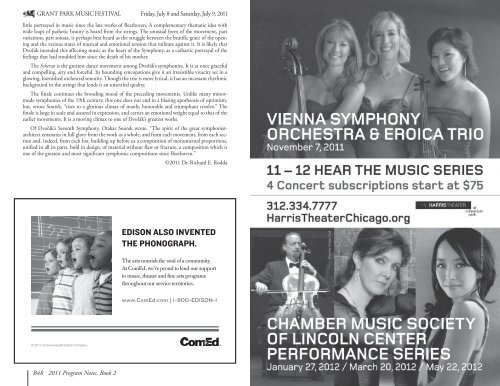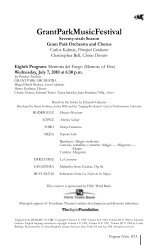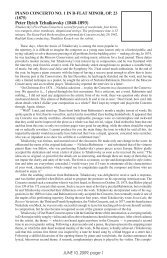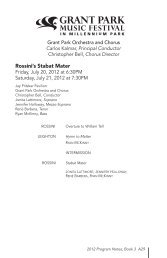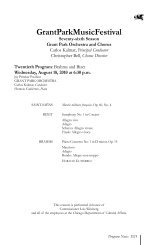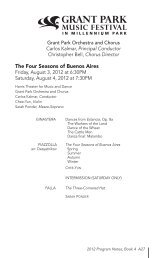2011 Program Book 2 - Spanish Guitar - July 8 & 9.pdf
2011 Program Book 2 - Spanish Guitar - July 8 & 9.pdf
2011 Program Book 2 - Spanish Guitar - July 8 & 9.pdf
Create successful ePaper yourself
Turn your PDF publications into a flip-book with our unique Google optimized e-Paper software.
GRANT PARK MUSIC FESTIVAL Friday, <strong>July</strong> 8 and Saturday, <strong>July</strong> 9, <strong>2011</strong><br />
little portrayed in music since the late works of Beethoven. A complementary thematic idea with<br />
wide leaps of pathetic beauty is heard from the strings. The unusual form of the movement, part<br />
variations, part sonata, is perhaps best heard as the struggle between the beatific grace of the opening<br />
and the various states of musical and emotional tension that militate against it. It is likely that<br />
Dvořák intended this affecting music as the heart of the Symphony, as a cathartic portrayal of the<br />
feelings that had troubled him since the death of his mother.<br />
The Scherzo is the greatest dance movement among Dvořák’s symphonies. It is at once graceful<br />
and compelling, airy and forceful. Its bounding syncopations give it an irresistible vivacity set in a<br />
glowing, burnished orchestral sonority. Though the trio is more lyrical, it has an incessant rhythmic<br />
background in the strings that lends it an unsettled quality.<br />
The finale continues the brooding mood of the preceding movements. Unlike many minormode<br />
symphonies of the 19th century, this one does not end in a blazing apotheosis of optimism,<br />
but, wrote Sourek, “rises to a glorious climax of manly, honorable and triumphant resolve.” The<br />
finale is large in scale and assured in expression, and carries an emotional weight equal to that of the<br />
earlier movements. It is a moving climax to one of Dvořák’s greatest works.<br />
Of Dvořák’s Seventh Symphony, Otakar Sourek wrote, “The spirit of the great symphonistarchitect<br />
emanates in full glory from the work as a whole, and from each movement, from each section<br />
and, indeed, from each bar, building up before us a composition of monumental proportions,<br />
unified in all its parts, bold in design, of material without flaw or fracture, a composition which is<br />
one of the greatest and most significant symphonic compositions since Beethoven.”<br />
©<strong>2011</strong> Dr. Richard E. Rodda<br />
EDISON ALSO INVENTED<br />
THE PHONOGRAPH.<br />
The arts nourish the soul of a community.<br />
At ComEd, we’re proud to lend our support<br />
to music, theater and fine arts programs<br />
throughout our service territories.<br />
www.ComEd.com | 1-800-EDISON-1<br />
© <strong>2011</strong> Commonwealth Edison Company<br />
B48 <strong>2011</strong> <strong>Program</strong> Notes, <strong>Book</strong> 2<br />
<strong>2011</strong> <strong>Program</strong> Notes, <strong>Book</strong> 2 B49


